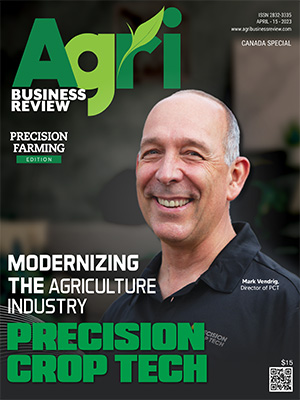Agriculture contributes to three percent of the global GDP, one-third of its contribution from a few decades ago. A significant cause for this decrease is the lack of innovation in the agricultural sector. Farmers use outdated techniques to spray pesticides and fertilizers, which are inefficient, tiring and hazardous to their health. Combined with changing weather conditions and complex geography, covering a large area becomes challenging even with the help of tractors. This inhibits farmers from being cost and time-effective in their operations, diminishing their output. Modern farming must shift from conventional to precision farming to solve these challenges.
Keeping these factors in mind, Precision Crop Tech (PCT), a technology-driven equipment supply and service company, is assisting farmers in boosting production, increasing efficiency and lowering input costs. It is Canada’s leading provider of agriculture drone sales, services, and consulting solutions with state-of-the-art technology.
“We don't just sell a drone; we help people understand how they work so they can efficiently and effectively spray their fields,” says Mark Vendrig, director of PCT. The company’s capabilities in providing a complete assessment of how plants respond to the soil chemistry and landscape and subsequently providing targeted drone spraying help it stand out in the market by assisting clients to make an informed, targeted approach to field management. Holding years of experience working with drones and their functioning, PCT aims to become the leading service provider and supplier of clean energy UAV and robotic solutions for agriculture, mining, and forestry.
PCT offers services like multispectral field imaging and terrain mapping. In addition, it obtains a wide variety of products from its three suppliers; DJI, Hylio, and TTA, whose drones are tried and tested to perform specific functions. Customer feedback plays a vital role in developing drones and technology because it enables PCT to work with suppliers to tailor the products to meet client requirements.
For instance, an Okanagan, BC, client wanted their vineyard sprayed. The application was challenging because the same spray height had to be maintained above all crops, and the vineyard was on a steep and undulating slope. The customer had previously used tractors, which proved difficult to maneuver and resulted in inconsistent spraying. PCT first created an algorithm using plant height and slope data collected with LIDAR mapping. Then using the drone's ground radar and RTK navigation system, the drone flew in autopilot following the slope and varying the spray height according to the crop's height.
All Precision Crops Tech’s machines run on battery power and are green, reducing carbon emissions. PCT is also driven to reduce the amount of chemical used on fields; targeted spraying with drones decreases agriculture's environmental footprint. In addition, using its UAV technology, PCT and its clients, can focus on delivering spot treatments or variable-rate nutrient treatments, thereby reducing nutrient, herbicide and pesticide usage. This year, PCT aims to shorten the time between field data collection and drone delivery of treatments, targeting a same-day diagnosis and solution delivery program. PCT has also increased the size of its fleet of aircraft and automated data processing to serve more clients in significantly less time.
Precision Crop Tech is also working with regulators and suppliers, conducting trials to get drone applications of herbicides and pesticides approved, a long process in Canada. After five years of trials, the first products are now being approved in Canada. The trials show that less product can be used to achieve the same results as other spraying technologies. Although the trials and approval process takes long in Canada, there is now sound scientific proof that drones provide a competitive edge to farmers while reducing the environmental footprint of farming.
Keeping these factors in mind, Precision Crop Tech (PCT), a technology-driven equipment supply and service company, is assisting farmers in boosting production, increasing efficiency and lowering input costs. It is Canada’s leading provider of agriculture drone sales, services, and consulting solutions with state-of-the-art technology.
“We don't just sell a drone; we help people understand how they work so they can efficiently and effectively spray their fields,” says Mark Vendrig, director of PCT. The company’s capabilities in providing a complete assessment of how plants respond to the soil chemistry and landscape and subsequently providing targeted drone spraying help it stand out in the market by assisting clients to make an informed, targeted approach to field management. Holding years of experience working with drones and their functioning, PCT aims to become the leading service provider and supplier of clean energy UAV and robotic solutions for agriculture, mining, and forestry.
PCT offers services like multispectral field imaging and terrain mapping. In addition, it obtains a wide variety of products from its three suppliers; DJI, Hylio, and TTA, whose drones are tried and tested to perform specific functions. Customer feedback plays a vital role in developing drones and technology because it enables PCT to work with suppliers to tailor the products to meet client requirements.
For instance, an Okanagan, BC, client wanted their vineyard sprayed. The application was challenging because the same spray height had to be maintained above all crops, and the vineyard was on a steep and undulating slope. The customer had previously used tractors, which proved difficult to maneuver and resulted in inconsistent spraying. PCT first created an algorithm using plant height and slope data collected with LIDAR mapping. Then using the drone's ground radar and RTK navigation system, the drone flew in autopilot following the slope and varying the spray height according to the crop's height.
We don't just sell a drone; we help people understand how they work so they can efficiently and effectively spray their fields
Precision Crop Tech is also working with regulators and suppliers, conducting trials to get drone applications of herbicides and pesticides approved, a long process in Canada. After five years of trials, the first products are now being approved in Canada. The trials show that less product can be used to achieve the same results as other spraying technologies. Although the trials and approval process takes long in Canada, there is now sound scientific proof that drones provide a competitive edge to farmers while reducing the environmental footprint of farming.
Company : Precision Crop Tech
Headquarters :
Abbotsford, BC,Canada ManagementMark Vendrig, Director of PCT
Thank you for Subscribing to Agri Business Review Weekly Brief



